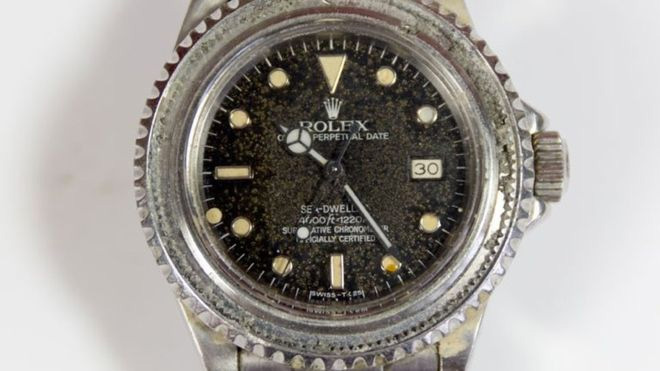At the cost of sounding greedy, I wish people would spend time finding the mythical ‘Heart of the Ocean’ from the movie Titanic or the treasures of the lost city of Atlantis, and make us rich. However, we’ll have to make do with realistic tales of lost-and-found Rolex watches to warm our hearts.
Tale One – Rolex Submariner

The story goes that someone was fishing off the west coast of British Columbia and they had their Rolex Submariner on their wrist. Apparently, the clasp of the watch got hooked into the fishing rod and it broke the pin on the bracelet, pulling the watch off. It sank to the ocean floor – of the Pacific Ocean no less – and all the owner could do at that moment was record the exact location of the drop with his GPS system.
Incredibly, fourteen months later, the workers the watch owner had hired, found the two-tone Sub. It had been resting in 100 meters of sea water, complete with attached sea barnacle on the bezel. With a bit of winding (40 winds) of the crown and some TLC, the watch was working and much to the relief of the owner, it survived its trial at sea.
Tale Two – Rolex Sea Dweller

Sam Brown had received a Rolex Sea Dweller for this 50th birthday and it was his most prized possession. His watch fell into the River Orwell and was found again after eighteen months of careful searching. He had almost lost all hope of finding the watch, but to his good luck, the watch survived the ordeal. And after servicing, was fully functional again.
The moral of the story
Hold on to your watches! That aside, the two stories go to show that Rolex has builds water-tight watches and to stand the testimony of time. Our recommendation is however, not to tempt fate, as you may not be as fortunate as those mentioned here. If salt water gets into your watch movement, the parts might corrode and render the watch beyond repair. Moreover, steel is also affected by long exposure to salt water.
As far as fresh water is concerned, watch experts recommend that should it get inside the watch, you should never try and dry it out by opening the caseback. A wet watch movement will ususally rust as soon as it is exposed to air. So you have to be mindful of that.
The Rolex Way
Rolex prides itself on the intense tests that it conducts on their watches, typically extreme conditions that they are unlikely to ever encounter. The trials are designed to make sure that the watches perform flawlessly in any real-world condition. For example, a new generation Oysterlock is fitted on Professional Rolex models and it went under 26 different types of drop tests as it was being developed. The watches were immersed in tanks of chlorine and salt water with added sand. The rigor was immense and the outcome, exceptional.
Before they are launched, Rolex watches endure 20 different drop tests and the most severe homologation test is the bélier. In this test, the watch is subjected to an impact equivalent to 5,000 G, hundreds time more than a regular car crash test.
To sum it up, you can be sure you have a good piece in the hand when it’s a Rolex, and the two incidents mentioned above reinforce this fact. And remember, the watch looks best on your wrist!
Via versatile1 and BBC



